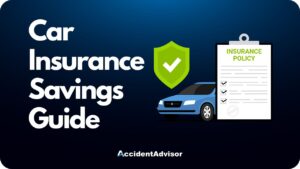If you are wondering who is at fault in a car accident when backing up, you or someone you know may have been in a car crash involving negligence. If so, determining fault in your case for compensation will depend on establishing which driver had the right of way at the time of the accident. Significantly, this determination can change depending on where the accident took place, the rules of the road, and the testimonies of the drivers and witnesses.
Continue reading for our guide on establishing fault in a car accident involving a driver backing up. Each driver will likely view the events differently, so establishing a concrete basis for negligence is key to determining fault.
Speak with a personal injury attorney experienced in car accident cases to learn whether you or another driver was at fault in a car accident when backing up. You may be eligible for compensation even if you were partially at fault, depending on the conditions of the accident and the laws of your state.
Table of Contents
- How Common are Car Accidents When Backing Up?
- Is the Person Backing Up Always at Fault?
- How Do You Determine Fault in a Car Accident When Backing Up?
- Common Car Accidents that Involve Backing Up
- Common Injuries for Car Accidents When Backing Up
- How to Prevent Car Accidents When Backing Up?
- How to File a Claim for Backing-Up Car Accidents?
- Conclusion
How Common are Car Accidents When Backing Up?
Car accidents that occur when a car is backing up are very common. According to a report filed to Congress by the NHTSA in 2008, backing-up accidents were responsible for over 15,000 nontraffic accident situations and over 19,000 traffic injuries. These accidents accounted for 463 fatalities that year.
As the number of traffic accident-related fatalities has spiked in recent years, with 2020 being the highest year since 2007, backover accidents have increased as well. A “backover accident” is the name of an accident in which a car, truck, or SUV backs up into a pedestrian, cyclist, or another car.
These accidents can result in serious injuries or fatalities, especially since the driver backing up may not realize they have hit someone right away. If the victim is a pedestrian or cyclist, immediate medical attention is always required. This means not only that backover accidents are more dangerous but also that they are more often reported. Unlike other types of crashes, fault is easier to determine since the law has different views of the driver who was backing up and the victims they backed up into.
Is the Person Backing Up Always at Fault?
While both drivers will likely argue for their innocence, the law usually views the vehicle backing up as being at fault for the accident. This is because of the concept of right of way, which could be determined by the police officer on the scene or challenged by the judge or jury later.
For the conditions of the road on which the accident occurred, state laws help define who had the right of way. This is why it can matter where the accident takes place when determining fault. For example, while many states give the driver that wasn’t backing up the right of way, Florida is one state that doesn’t give the right of way to anyone. Instead, it defines when a driver must yield the right of way to someone else, which can change the outcome of a case involving fault in a car accident when backing up.
How Do You Determine Fault in a Car Accident When Backing Up?
Despite these differences in state laws, fault can often be determined based on the situation. If a driver was backing out of a driveway when they hit someone, they were probably at fault. When one car is stationary, the moving car is usually at fault. Finally, if one car was not following the rules of that road or parking lot at the time, that driver will likely be charged with negligence and determined to be at fault for the accident.
However, generalities can only get you so far. Consider these factors when determining fault for an accident involving a car backing up.
Did the Driver have the Right of Way?
As mentioned, this is the most significant factor. Sometimes, both drivers made mistakes, so the right of way isn’t as clear-cut. It may come down to the statements given by each driver and the inspector’s determination of the factors that contributed to the crash.
This is why you should always speak concisely, sticking to facts and keeping the timeline of events straight. In an accident where you were backing up, especially out of a driveway, into a pedestrian or stationary car, or in violation of the rules of that road, you are probably at fault. Therefore, if you were the driver or person that was hit, you probably had the right of way.
Was the Hit Vehicle Stopped or Moving?
This is always a significant question in cases involving fault in a car accident when backing up. In general, the stopped vehicle can’t be at-fault for the accident unless they are in serious violation of traffic laws, such as being parked illegally.
This applies to traffic situations as well, such as a case in which the hit car was stopped at a light or sign when the accident occurred. If the hit car is moving, the case is a little more complicated because either driver could have violated the rules of the road.
Witness Statements
When fault cannot be easily determined by the drivers’ statements, witness statements can become important pieces of evidence.
The officer and insurance adjuster on the scene may record statements from people who saw the accident, as well as take down their contact information if their statements need to be verified later. Witness reports can change how fault is determined since they can verify which car was moving, how fast they were going, and other conditions of the accident.
If you believe that the other driver was at-fault for the accident, you can use witness statements to your advantage. After the accident, assuming you’ve checked to make sure no one is hurt and police are on their way, you can record witness statements and save their contact info for you and your attorney later.
Location of the Damage
The location of the damage on each car can affect how fault is determined. This damage may verify one driver’s story over the other, in addition to suggesting other aspects of the accident such as the speed of the cars, their relative locations, and how they were behaving on the road.
Common Car Accidents that Involve Backing Up
There are several common types of car accidents involving a car that was backing up, distinguished by the location of the crash. The location matters because where the accident occurred can change the rules of the road, which can change how fault is determined.
Car Accident When Backing Up in a Parking Lot
Backing up in a parking lot is a common example of this type of accident. Fault usually falls to the car backing up since the car moving in the lane has the right of way.
Car Accident When Backing Out of a Driveway
When backing out of a driveway, the car backing up is usually at-fault as well. This is because the cars on the road have the right of way. This can change, however, if the hit vehicle was speeding or disregarding a rule on that road.
Common Injuries for Car Accidents When Backing Up
If a backover accident involves a pedestrian or cyclist hit by a car, injuries could include brain trauma, broken bones, internal bleeding, or severe organ damage. Many common injuries for car accidents when backing up overlap with other types of car accidents, but they can be more severe.
On the other hand, the driver backing up commonly suffer less serious injuries from this type of accident, including bruising, whiplash, and potential small fractures due to the sudden stop at the moment of impact. Around half of all people killed in accidents involving backing up are children younger than three years old, so this makes even common backover injuries exponentially more severe.
How to Prevent Car Accidents When Backing Up?
The best way to prevent car accidents when backing up is to check and recheck your surroundings while doing it. Just because it’s clear when you start backing up doesn’t mean the conditions will stay the same all the way out into the road. Back up using the back window with your right arm over the back of the other seat and your left hand on the steering wheel.
To effectively use your mirrors, always make sure they are properly adjusted for your eye level. Use them to reduce your blind spots, even if you have a backup camera installed. This is especially true if someone else drove your car last since they may have adjusted them.
Reverse slowly when pulling out and think ahead of time which direction the wheel will go. You can also park defensively, staying clear of spaces that are too near crowded pedestrian walkways, alleys, or driveways, where backover accidents are most likely to occur.
How to File a Claim for Backing-Up Car Accidents?
To file a claim for backing-up car accidents, you need to stay on top of the available reports and the necessary evidence. This means first obtaining a copy of the police report at the scene, recording evidence of the damage on your phone, and getting the contact information of the other parties involved as well as any potential witnesses.
Next, you need to make sure to keep your injuries and car repairs well-documented. Never refuse medical attention as insurers can use this against you later. See an accredited emergency room or primary care doctor ASAP regardless of whether emergency medical personnel were called to the scene.
Finally, you need to speak with a car accident lawyer about when and how you should file this evidence in your case. Remember that in personal injury cases, each state has its own statute of limitations. An attorney can make sure you file on time and get the compensation you deserve.
Conclusion
Determining fault in a car accident when backing up can be more complicated than simply blaming the moving vehicle, especially if two moving cars hit each other. However, when pedestrians or cyclists are involved, or when one car is stationary, the moving vehicle is nearly always at-fault for the accident.
If you were injured in a backing-up car accident or were the driver in one, contact an experienced car accident attorney to learn about your eligibility for compensation or your defense strategy, depending on which you need.

Rocky Horton
Author
Rocky Horton is a health and safety expert from Chapel Hill, NC. He is the founder of AccidentAdvisor and has been featured in Forbes, Bloomberg, and other publications. Learn more.













